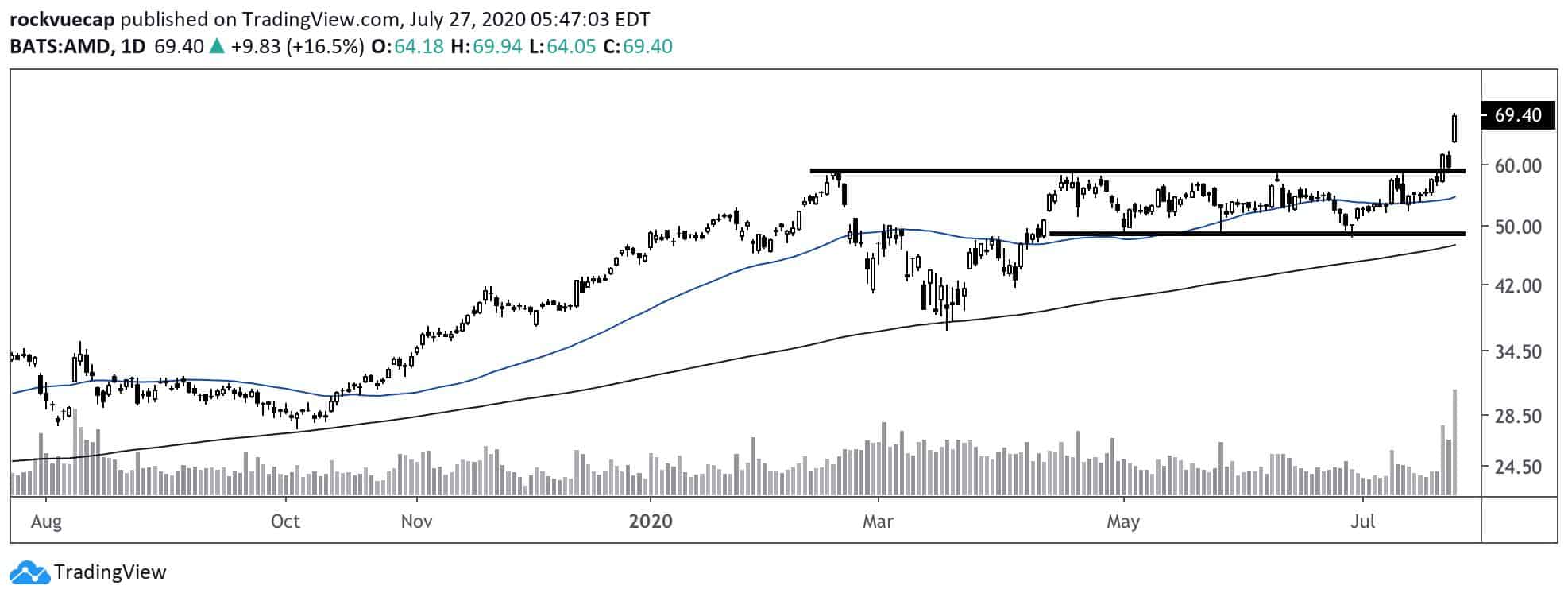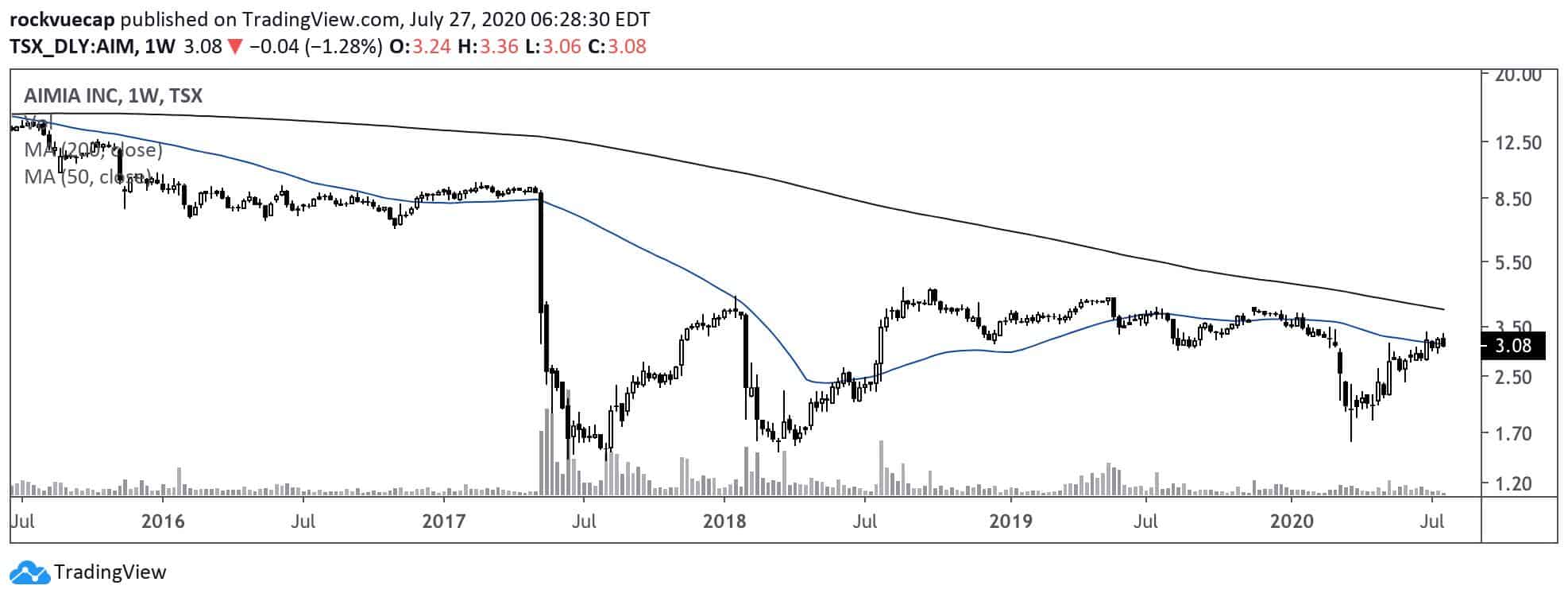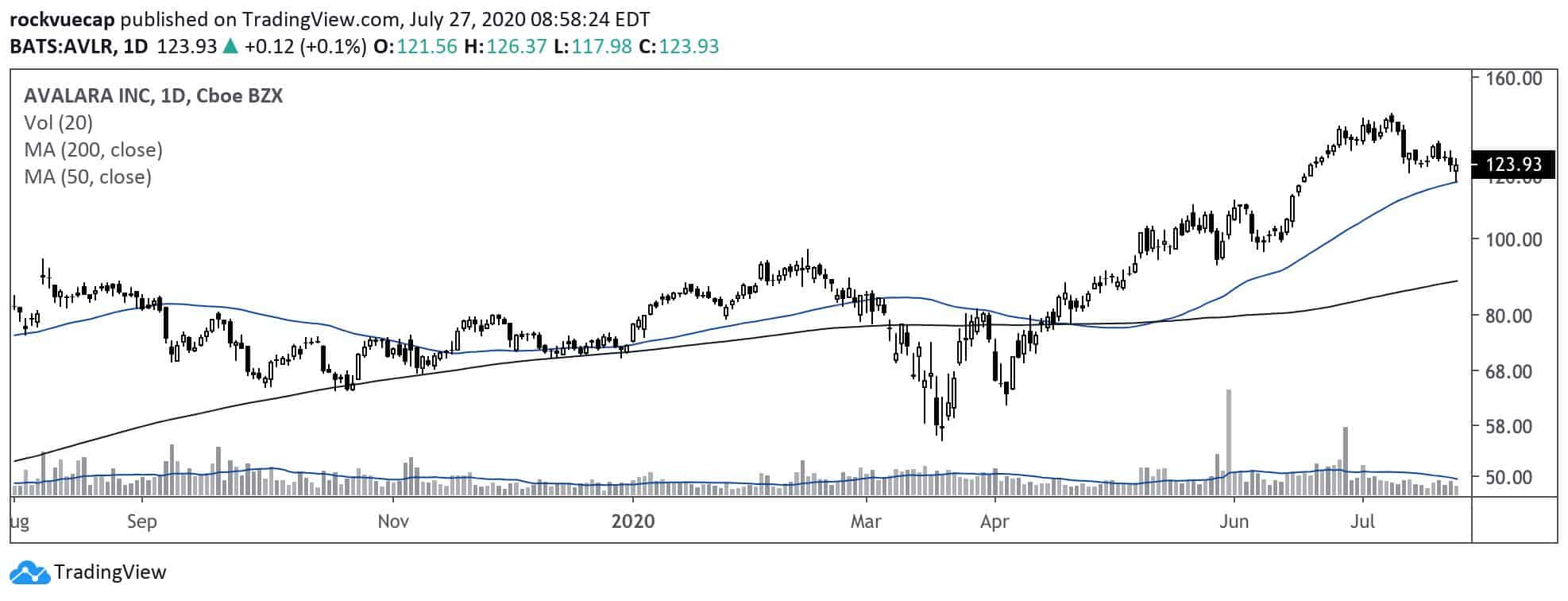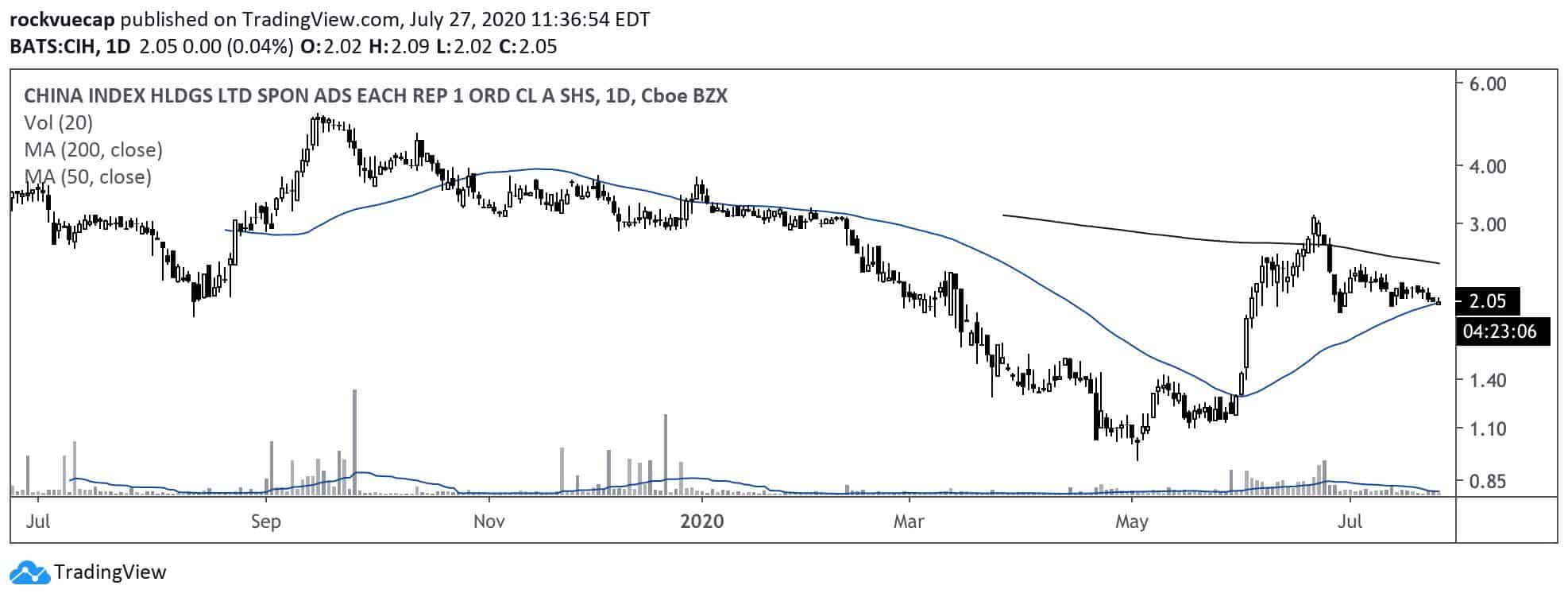Hope you had a great weekend! Can’t believe we’re almost through July. Where did the month go? Is it me, or does it feel like months fly-by when the market goes up? Anyways, we’re halfway through 2020 and things get weirder each day.
As a reminder, the Pentagon said they’d release proof of alien spacecrafts soon. That’s incredible. I can’t wait for someone to create a SPAC and pitch investors on harnessing its technology.
We’ve got a good edition for y’all!
Our Latest Podcast Episodes:
Here’s the letters we cover this week:
-
- Laughing Water Capital
- Greenhaven Road Capital
- Tao Value
We also feature the best podcast we listened to last week and a wholesome tweet.
Let’s dive in!
—
July 29th, 2020
Chart Of The Week: Intel’s (INTC) chip delay sent the semiconductor market spinning. A $44B swing in company valuations took place within one trading day. INTC dropped 16.24%. AMD rose 16.51%. It’s clear which company Mr. Market thinks will win the chip game.
We alerted our members to a possible AMD breakout a week before its initial surge. Our members that took the initial breakout are sitting on decent profits. We’ll see if AMD can follow through.
__________________________________________________________________________
Investor Spotlight: More & More Q2 Letters!
Many fund managers released their Q2 letters over the weekend. We’re profiling three this week. Let’s start with Laughing Water Capital.
Laughing Water Capital:
Matthew Sweeney runs Laughing Water Capital (LWC). The fund returned 29.50% during Q2, bringing the YTD total return to 3.6%. Sweeney spends the entire letter talking about investments and businesses. I love it.
No fluff on COVID-19. Pure business and investing commentary. You can read the entire letter here.
LWC’s Top 4 Disclosed Positions
1. Aimia, Inc. (AIM.TSX)
Sweeney’s Take (emphasis mine): “While there is still more to be done, in the few short months they have been in control, the new team has been moving at a blistering pace to transform Aimia from a loyalty company whose board and management had zero economic incentive to do anything other than allow the company to flounder, to a holding company managed by a group whose ~25% and growing ownership of the company strongly incentivizes them to create value for the benefit of all shareholders”
New management is getting their hands dirty quick. Since joining, they’ve reduced corporate costs by 50%, moved loyalty assets off the balance sheet and laid the groundwork for a $2.00/share dividend recap.
Air travel remains a concern in the short-term. But there’s real value in airline loyalty programs. Heck, American Airlines might use their loyalty points as collateral for new debt!
Here’s AIM’s chart:
The stock’s gone nowhere for three years and remains in a downtrend (below 200MA). A new sell-side analyst placed a $9.50 price-tag on the company’s shares. Any breakout above 200MA would be a good sign towards that figure.
2. API Group (APG)
Sweeney’s Take (emphasis mine): “APG is a holding company with multiple specialty contracting businesses under its umbrella. Most notably, APG is the largest provider of fire safety systems in the U.S., with a focus on service, which is mandated by law. Regardless of whether there is a recession, building owners must maintain the fire safety systems in their buildings, which provides defensive cash flows in an industry that can otherwise be cyclical.”
APG is a London-based SPAC formed by Martin Franklin. According to the letter, Franklin has a history of building great businesses. Jarden (JAH), for example, compounded capital at 30%/year for fifteen years.
APG’s recession-proof business trades less than 1x revenues and <10x EBITDA. You can read their 2019 Annual Report here.
Given the boring and mandated nature of the business, I’ve added APG to my watchlist.
3. Benefytt Technologies (BFYT)
Sweeney’s Take (emphasis mine): “A discussion of BFYT is moot at this point because after the end of the quarter and prior to the completion of this letter the company was acquired. The short version is that BFYT fit our criteria well in that it was a recession proof business with clear reasons to explain why we might be so lucky to purchase it cheaply.”
The company was acquired for roughly $31/share. A near 40% premium from its early July trading price.
4. PAR Technology Corp (PAR)
Sweeney’s Take (emphasis mine): “… the bulk of the value is in the company’s cloud-based Point of Sale (POS) system, which to date primarily serves fast casual and quick serve restaurants. While overall COVID has been disastrous for restaurants, it seems likely that independents will be the big losers, while larger, more established chain brands will take market share going forward, which benefits PAR. Importantly, fast casual and quick serve are recession resilient as consumers tend to trade down during difficult times.”
The company’s currently burning money as they invest in growing total restaurants served. The strategy’s working as the company’s grown top-line revenue 13% and 22% over the last two quarters.
Let’s take a look at the charts:
PAR must break the $35 overhead resistance to reach new highs.
Greenhaven Road Capital: +50% Q2 2020
Scott Miller’s fund returned over 50% during the second quarter. This came off the heels of the fund’s worst quarter, so YTD returns remain in the single digits. You can read his letter here.
Miller highlights three new investments made during Q2:
-
- Gogo, Inc. (GOGO)
- Lands’ End (LE)
- IAC/Interactive Corp (IAC)
Let’s break ‘em down.
1. Gogo, Inc. (GOGO)
Business Description: Provides inflight broadband connectivity and wireless entertainment services to the aviation industry in the United States and internationally. It operates through three segments: Commercial Aviation North America (CA-NA), Commercial Aviation Rest of World (CA-ROW), and Business Aviation (BA). – TIKR.com
Miller’s Take: “If air passenger travel remains depressed for five years and we are in a prolonged recession/depression, Gogo is unlikely to be a profitable investment. However, with $200M in cash, a valuable private aviation division, and a highly incentivized CEO, there are several paths to a positive outcome, many of which likely would lead to multiples of our original investment.”
GOGO generates 50% gross margins and over the previous four quarters generated ~5% operating margins.
The company has loads of debt (6.7x Net Debt / EBITDA) and negative core free cash flow (excluding write-downs and changes in “other operating assets”).
Given the non-zero possibility of bankruptcy, Miller’s made it a 1.50% position at cost.
Here’s the chart:
The stock remains in a clear downtrend below the 50MA and 200MA.
2. Lands’ End (LE)
Business Description: Lands’ End, Inc. operates as a uni-channel retailer of casual clothing, accessories, footwear, and home products in the United States, Europe, Asia, and internationally. – TIKR.com
Miller’s Take: “Historical financials were negatively impacted by the company’s withdrawal from Sears stores and investments in online infrastructure, and were thus not necessarily indicative of their future profitability. The last Sears store closed in January, winding down almost $200M of unprofitable sales from a few years prior. With just 25 physical stores compared to +$1b in sales, Lands’ End is well-positioned versus peers who are battling much higher fixed costs and aged inventory collecting dust on the shelves.”
A big part of the bull thesis is the current CEO’s (Jerome Griffith) ability to turn the company around. Miller notes a couple recent turnaround projects within the company:
-
- Increase distribution through Amazon (AMZN)
- Launching partnership with Kohl’s
Yet there remains clear headwinds for the company going forward. LE is 4x leveraged on an EBITDA basis and 7x on a FCF-proxy basis (EBITDA-capex). The company’s increased inventory and cash conversion cycle, two things you don’t want to see in a retailer. On top of that, gross margins are roughly 300bps lower than five years ago.
LE can change all that if they execute on their strategy and become an omni-channel powerhouse.
Let’s take a look at the chart …
LE looks close to a trend reversal on the daily chart. It’s above the 50MA and forming a tight symmetrical triangle (notice the low volume). A breakout above the 200MA would confirm the new bull trend.
3. IAC/Interactive Corp (IAC)
Business Description: “IAC/InterActiveCorp, together with its subsidiaries, operates as a media and Internet company in the United States and internationally. The company’s Match Group segment provides subscription dating products under Tinder, Match, Meetic, OkCupid, Hinge, Pairs, PlentyOfFish, OurTime, and other brands. Its ANGI Homeservices segment connects consumers with service professionals for home repair, maintenance, and improvement projects.”
Miller’s Take: “By investing in IAC, we also receive Vimeo – a global video sharing platform with ~1.3mm paid subscribers, Dotdash – an online publisher with 90mm+ monthly users, and Applications, which is comprised of 40 mobile applications and 155 browser extensions. The Applications basket includes Apalon (mobile development company with 25M monthly users), Ask Applications (distributor of desktop applications with 60M monthly users), Daily Burn (membership-based fitness platform with 1.7K curated videos), iTranslate (more than 100M app downloads), Mosaic Group (3.8M paying subscribers), and RoboKiller (blocks over 1.1M telemarketers).”
The bull thesis for IAC is well-documented and the stock’s venturing on Hedge Fund Hotel status. Seemingly every value investor letter I read mentions an investment in IAC.
For those interested in more IAC commentary, check out my second podcast with Richard Howe of StockSpinoffInvesting.com.
Tao Value: +36.45 Q2 2020
Anonymous Tao Value reported 36.45% returns in the second quarter. This brings the partnership’s YTD total to 18.76%. Since inception, Tao Value’s returned an annual 17.11% return, far outpacing MSCI ACWI index. You can read the investor letter here.
Tao’s largest benefactors in Q2 were Sea, Ltd (SE), Pinduoduo (PDD) and Joy Inc (YY). The only detractor in the portfolio was an ACWI index ETF short.
The letter highlights two new investments in Tao’s portfolio:
-
- Avalara (AVLR)
Business Description: Avalara, Inc., together with its subsidiaries, provides cloud-based solutions for transaction tax compliance worldwide. The company offers a suite of compliance solutions that enable businesses to address the complexity of transaction tax compliance; process transactions in real time; produce detailed records of transaction tax determinations; and reduce errors, audit exposure, and total transaction tax compliance costs. – TIKR.com
Tao’s Take (emphasis mine): “ I believe AVLR has built a narrow moat by closely integrated with over 700 business applications (e.g. ERPs, Marketplaces). Management also see the importance of “partnering with all applications that create invoices”, which will create superior streamlined user experience. This also explains why Sales & Marketing expenses has been high as AVLR had been aggressively establishing such partnerships and sharing referral fees.
The moat can be visually seen from the 110% average net revenue retention rate, which means existing customers a year ago, after adjusting for termination, pricing change & upsells, pays AVLR 10% more on aggregate today. The churn rate is consistently lower than 5%, implying customer life of 20+ years. Both metrics speak for the stickiness of the products. “
The company’s grown unearned revenue from $48M in 2015 to $165M in 2019. Over time AVLR should recognize this revenue, which we’re starting to see in the cash flow statement. The company collected $42M and $38M in unearned revenue over the last two years respectively.
AVLR’s growing top-line revenue at a 30% 5YR CAGR. But at the current price, you’ll have to pay up for that growth. The company trades near 20x forward revenues.
It’s a great, sticky, boring business with high incremental margins. Let’s go to the charts …
A breakdown below the 50MA could present a buying opportunity and a chance to pick up some shares at much lower EV/Sales valuations.
-
- China Index Holding (CIH)
Business Description: China Index Holdings Limited operates a real estate information and analytics service platform in China. The company offers promotion services, including a number of online and offline themed campaigns, industry forums, periodic updates, and online promotions to its customers to promote their brands. – TIKR.com
Tao’s Take: “CIH’s core business is to collect, clean and sell real estate data & research to all RE participant in China, a good asset-light business. The business has high 40+% operating margin, and still growing at 20~%. Yet it was traded at some absurdly low valuations, like 4x PE or 3x EV/EBIT. One reason for such low valuation can be attributed to the poor governance under the Chairman Vincent Tianquan Mo and his valuation destruction history at SFUN. Another reason is possibly that Mo 4 decided to use direct listing (which was only successfully pulled off by a few very well-known companies, like Spotify & Slack), and without any financial advisor. As a result, CIH still have no institution equity research coverage yet.”
CIH immediately piqued my interest. It checks a lot of my boxes:
-
- Small and obscure
- International (less fished ponds)
- Capital-light business model that can reinvest at high rates of return
- High margins
- Not expensive on a forward-looking basis
CIH remains the leader in real estate data analytics via SaaS platforms. Their closest competitor, E-House, is more of a broker than a data analysis company.
Let’s check out the chart …
The stock’s pulling back towards its 50MA on low volume. This looks like an ideal pullback buying set-up. But we’ll need further consolidation and a strong breakout to the upside to confirm our hypothesis.
__________________________________________________________________________
Podcast of The Week: Eric Vishria, SaaS & Software
Eric Vishria joined Patrick O’Shaughnessy’s Invest Like The Best podcast to chat all things software and SaaS. You can’t go wrong listening to someone at Benchmark Capital. Gurley and company sure know how to pick ‘em.
If you’re interested in software and SaaS businesses, this podcast is a must listen.
One day I’ll have Gurley on the podcast. One day!
__________________________________________________________________________
Tweet of The Week: Don’t Take Life Too Seriously
Don’t take life so seriously pic.twitter.com/z9o7VTiK1t
— jason@calacanis.com (@Jason) July 26, 2020
I love tennis and this tweet is pure wholesome fun. It’s a friendly reminder to all not to take life too seriously. We get one shot at this thing. Laugh at yourself. Joke. Have some fun!
__________________________________________________________________________
That’s all I got for this week. Shoot me an email if you come across something interesting this week at brandon@macro-ops.com.
Tell Your Friends!
Do you love Value Hive?
Tell your friends about us! The greatest compliment we can receive is a referral (although we do accept Chipotle burrito bowls).
Click here to receive The Value Hive Directly To Your Inbox!


















